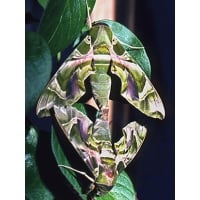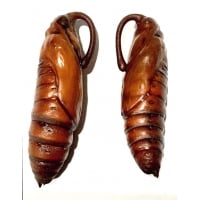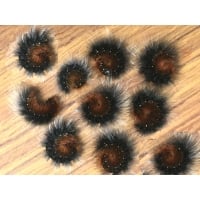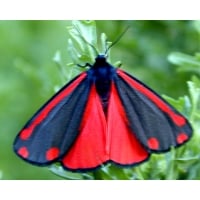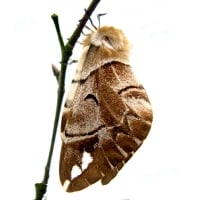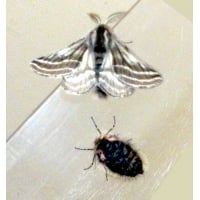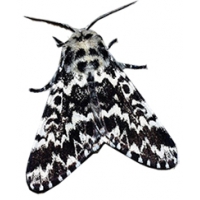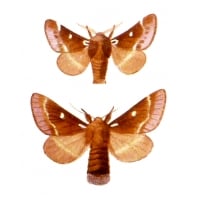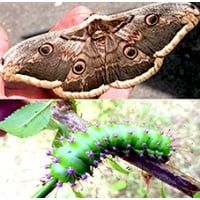CURRENT PUPAE - Chrysalides and cocoons
If you are a beginner and need information on rearing from small caterpillars, or hatching out pupae, please order the All Colour Paperback BUTTERFLIES. INSTRUCTIONS ARE NOT SENT WITH EACH SPECIES, you need to acquire basic skills and this book is a simple way of doing so.
Please Select a Category Below:
Oleander Hawkmoth Daphnis nerii
One of the finest of all Hawkmoths. They can be bred in captivity. The larvae are very fast growing indeed. Most breeders rear the larvae on Privet Ligustrum. The larvae thrive on Periwinkle Vinca, and in the wild they are found on Oleander Nerium.
Pupae can be kept warm (20ºC) and moist to emerge this autumn/winter, or they can be kept cool to emerge and breed in the spring.
To overwinter autumn pupae, bury the pupae in light compost that is not too damp but not allowed to dry out. The top of each pupa should be just showing. Store in a cool place (10-12 degrees C) away from predadors. Bring into the warm in April ready for May emergence.
In the emerging cage, underground pupae need to be in moist compost or kept as described for the Pupae Nest on this website.
Convolvulous Hawkmoth convolvuli Herse convolvuli
The pupa has an exceptionally large proboscis case protruding, like a jug handle! Keep the pupae warm and they will produce adults this summer. Otherwise you can store the pupae cool for the winter and allow to hatch in May/June.
The larvae feed on most Convolvulous species. The moth likes to feed from deep throated flowers (Tobacco Nicotiana is a favourite).
Females lay a large number of eggs.
Garden Tiger Moth Arctia caja
Young larvae that in the wild would hibernate and if kept warm and active, could develop and produce another generation this year. If young larvae are released into hedgerows, there is the opportunity to introduce Woolly Bears back into the countryside, where once they were abundant each spring.
Garden Tiger larvae Woolly Bears grow fast on Dock, Dandelion, Dead Nettle, Nettle and many other hedgerow plants, also Pussy Willow Salix caprea and Osier Willow Salix viminalis. You can also feed them conveniently on Cabbage.
Now a most difficult species to obtain.
In the wild, late summer larvae would hibernate, but if you keep them warm and light, many will produce another generation this year.
If you wish to hibernate Wooly Bears, sleeve them in autumn on Willow or Sallow (Pussy Willow). The falling leaves curl to form a ventilated ball in which the larvae hibernate. If all goes well in winter the larvae emerge in spring and feed from the new spring leaves.
Cinnabar Moth Hipocrita jacobaeae pupae
Once an extremely common British Moth, less common over most of Europe, but over the last 10 years there has been a marked decline in numbers. The summer of 2016 brought a reversal of this decline and we have a fine stock of pupae available, as a result of breeding.
The larvae feed on Groundsel and Ragwort Senecio. The larvae are ringed in bright orange and black, nature's warning colours, and they absorb chemicals from the foodplant that adversely affect predators who ignore the warning. Ragwort is a mis-understood plant that provides an abundance of nectar to bees, butterflies and other insects. There is evidence that Ragwort plants that are pulled up and left to dry, can be detrimental to cattle and horses if they eat the dried plants. Animals can be seen grazing safely in fields containing growing green plants. There is nothing to be gained from pulling up Ragwort plants, because they are biennials that flower and die in the same year. So a patch of Ragwort can provide valuable nectar to thousands of wild insects, and be host to Cinnabar larvae and, job completed, it dies at the end of summer.
The Cinnabar moth flies by day, more than by night, and is protected from predators, by the very striking colours of charcoal and scarlet, and bitter-tasting chemicals derived from the larval foodplant, enabling the moth to display its bright colours, yet not be attacked by predators.
Cinnabar larvae can be raised in sleeves on growing Ragwort. We find the sleeves fitted with a zip are particularly successful. When the larvae are large, if you put in the sleeve several handfuls of springy wood shavings or dried leaf litter, they will form thin silken cocoons in which to pupate.
Could you help to spread this colourful day-flying moth again in your area?
Store pupae cool for the winter, even in a fridge, loose in a plastic box, without any padding. In May lay them out in an emerging cage and wait for the moths to emerge.
Cinnabar Moth Hipocrita jacobaeae pupae
Once an extremely common British Moth, less common over most of Europe, but over the last 10 years there has been a marked decline in numbers. The summer of 2016 brought a reversal of this decline and we have a fine stock of pupae available, as a result of breeding.
The larvae feed on Groundsel and Ragwort Senecio. The larvae are ringed in bright orange and black, nature's warning colours, and they absorb chemicals from the foodplant that adversely affect predators who ignore the warning. Ragwort is a mis-understood plant that provides an abundance of nectar to bees, butterflies and other insects. There is evidence that Ragwort plants that are pulled up and left to dry, can be detrimental to cattle and horses if they eat the dried plants. Animals can be seen grazing safely in fields containing growing green plants. There is nothing to be gained from pulling up Ragwort plants, because they are biennials that flower and die in the same year. So a patch of Ragwort can provide valuable nectar to thousands of wild insects, and be host to Cinnabar larvae and, job completed, it dies at the end of summer.
The Cinnabar moth flies by day, more than by night, and is protected from predators, by the very striking colours of charcoal and scarlet, and bitter-tasting chemicals derived from the larval foodplant, enabling the moth to display its bright colours, yet not be attacked by predators.
Cinnabar larvae can be raised in sleeves on growing Ragwort. We find the sleeves fitted with a zip are particularly successful. When the larvae are large, if you put in the sleeve several handfuls of springy wood shavings or dried leaf litter, they will form thin silken cocoons in which to pupate.
Could you help to spread this colourful day-flying moth again in your area?
Store pupae cool for the winter, even in a fridge, loose in a plastic box, without any padding. In May lay them out in an emerging cage and wait for the moths to emerge.
Kentish Glory Endromis versicolora
Store pupae refrigerated until February/March when the adults emerge and breed. Provide Birch twigs for females to lay their clusters of yellow eggs. In normal cold conditions, the eggs don't hatch before the foodplant buds open.
This species is now found only in Scotland, and parts of Central Europe. These are European stock. Emerging as early as February. The first eggs and larvae are ready in March. Clusters of bright yellow eggs are laid on bare Birch twigs. Just go out and cut some twigs and arrange them in the cage. The eggs gradually change to a deep purple colour which matches the colour of the twigs. In captivity, the eggs can hatch before the Birch buds are open, so keep some twigs warm inside, standing in water, to get them to sprout.
If you can sleeve the larvae on a growing plant, potted or in the ground, rearing is very easy. The larvae, black at first, cluster on the twigs. Later they are green and spread out a little, clinging on to the twigs, they look just like Birch catkins. Absolute masters of camouflage. In May the larvae pupate in leaf litter and settle down until the new season starts again in February. This is a very easy species: just make sure you have enough growing foodplant (it can be in pots). The male and female moths share the same patterning, but the female is much larger and the male has particularly rich chestnut markings. Pairing is easy. Just leave the moths together and Nature takes care of things.
Note Kentish Glory larvae can also be fed on Hazel, Alder, Hornbeam, and Lime. It is probable that other alternative tree species may be used as foodplant.
Our thanks to Jens Stolt who has kindly allowed us to use his beautiful illustration of the life history of this rare species.
The Belted Beauty Lycia zonaria
In Britain this species is very rare indeed, and protected. Found in only about 3 localities on sandy nutrient-poor grassland or dunes. Very scarce in Holland, where it occurs in similar coastal areas. Our stock comes from central Europe, where it is sometimes found on dry limestone slopes where the vegetation is sparse.
Eggs are laid in batches particularly on grasses where they can be tucked into pockets and hollow stems. The larvae feed on a variety of vegetation - possibly almost anything that is growing amongst the grasses. They are recorded as feeding on Dandelion, Dock, Cow Parsley,Clovers, Kidney Vetch, Bird’s-foot Trefoil, Yarrow, Creeping Willows and Sallows, Hawthorn, Coltsfoot, Plantains, Burnet Rose and even Flag Iris. The larva, starting black with prominent white spots, becomes medium green, well camouflaged colour, but with a prominent lemon yellow lateral stripe. This is a Geometer - looper caterpillar. This is one of the few moths that has a wingless female. The female rests sometimes prominently where they more easily attract males, which fly by day and by night.
The pupa is formed only a little below the ground surface, where it spends the winter. Store winter pupae in a closed plastic box, very cool or refrigerated. To avoid desiccation don't leave in open air. In the emerging cage, keep moist at all times. See the Pupae Nest on this website. Emergence starts in the very early spring.
This is an opportunity not to be missed, to breed a very rare species and see its life history at first hand.
Pine Arches Moth Panthea coenobita
Very seldom offered. A Noctuid that has characteristics akin to the Tussocks. The caterpillar is beautifully coloured and patterned with tufts and tussocks of hair, giving it excellent camouflage on the twigs of its foodplants which are Pines Pinus, Spruces Abies and Larches Larix.
Coenobita is relatively unknown and few breeders have raised it. The species is found over many parts of Europe (excluding Britain) Spain and most of France. Its range extends to the Far East.
Small Eggar Moth Eriogaster lanestris
The moths emerge in March/April. On receipt of the pupae they should be refrigerated until spring. The moths form inside the cocoon in late winter. The moment the temperature rises, they burst forth, and it is inadvisable to let them do this too early, or any fertile eggs might hatch before there is any foodplant.
Because of modern practice of hedge management, this once common species is nowadays a rare find. Tight clipping of hedges destroys the habitat and undoubtedly the eggs and larvae.
Egg clusters are laid in batches, covered with black fluff from the tip of the female's abdomen, on branches of the foodplant Blackthorn Prunus spinosa or Hawthorn Crataegus monogyna. The larvae cluster, and even large larvae live within, and on the outsite of a prominent white tent of silk, very often at the end of a branch, with no attempt at concealment. It is likely that the larvae in captivity could be reared on Apple and Plum, though we have not tried these.
Don't be tempted to handle the larvae. They have short, decorative hairs, which easily come away and if they penetrate the skin, like short cactus prickles, this can give rise to intense irritation. No doubt this is why the larvae can afford to display themselves in the wild so openly. No predator will try to eat them once they learn, and the larvae are patterned in warning colours to advertise the danger.
To pupate, the larvae descend to form a tight cocoon with a smooth shell-like a nut, in concealed leaf litter or moss, where they spend the winter. In early spring, the moths are fully formed within the pupal shell, ready to emerge the moment they sense that conditions are right. If you take the nut-like cocoons from the cold and put them into room temperature, the moths will suddenly break open the ends of the cocoons and there will be a whole lot of moths in a very short time!
You might help to spread the species locally if you can find thorn hedges that are not regularly trimmed. Cocoons are immediately available. Keep them in the fridge until April. You will enjoy observing this species, in all its interesting stages, and maybe could introduce it to your area.
Monarch Butterfly (Milkweed) Danaus plexippus
This butterfly is officially on the British List, migrating to Britain on rare occasions, from islands off North Africa, and reportedly even from North America. Much larger than any other species on the list, this striking butterfly has powerful, yet graceful flight.
Pupae are received most months spring to autumn, not to any specific date.
The butterflies will emerge from the pupa in warm, moist conditions. This can be done at little over normal room temperature. They like 25-30 degrees C and will breed at these temperatures.
The butterflies like a warm greenhouse containing nectar plants, and this is the best place also for the emerging cage for the pupae. Shade the cage from direct sun which is too harsh.
The only larval foodplants are Milkweeds Asclepias and Silkweed Gomphocarpus, both of which grow well from seed. Asclepias seeds and even plants can be found on the internet. Gomphocarpus plants are advertised by http://www.curiousplants.co.uk/fur-balls-plant-asclepias-physocarpa-or-gomphocarpus-physocarpus-126-p.asp
Asclepias curassavica is an indoor plant, not frost-hardy, that grows fast and is excellent as a foodplant throughout the year in a greenhouse. There are hardy herbacious species (unsuitable for winter rearing). The most prolific for feeding quantities of larvae is Asclepias syriaca with multiple broad leaves and stems a metre or more high.
Beware: don't under-estimate the voracious appetite of larvae! Grow plenty of foodplant. The larvae and adults are strikingly marked with warning colours to deter predators, and they contain toxins from the foodplant that reinforce the warning! Several generations are produced each summer.
In the wild, the adults migrate south to warmer climate, where they hibernate in huge numbers, covering whole trees, like autumn leaves. The pupa is like a miniature Christmas tree bauble! Even if you do not have the foodplants to raise larvae, the emergence of the butterflies in your own emerging cage is a great experience.
Emperor Moth Saturnia pavonia
Britain’s only Silkmoth. The male and female have similar markings, but the female is larger, and the male is more brightly coloured.
Emergence is in March/April. Pairing is easy – if you have a female, she may attract males from miles away. The Emperor Moth occurs in many rural areas but is particularly found on heaths, where they breed on Heathers. The larvae feed on a variety of plants, including Bramble, Raspberry, Hawthorn, Blackthorn, Apple, Plum, Blackthorn, Oak, Hornbeam, Birch, Heathers and Heaths, Blueberry, Meadowsweet, Wild Rose, Sea Buckthorn, Purple Loosestrife, Willows especially Osier Salix viminalis, Pussy Willow (Sallow).
The caterpillars cluster in the early instars, eventually spreading out and becoming brightly coloured, as beautiful as such exotics as the Moon Moths. The cocoon is spun in the foodplant. An interesting construction with a neck and open end, through which the adult emerges.
Store cocoons in a plastic box in a fridge until March. The moths normally emerge in April.
This is one of the fun species to rear. Demand for this species is high. Please order early.
Giant Peacock Moth Saturnia pyri
Magnificent - Europe’s largest moth. Flies in May, pairs easily and lays prodigiously. Exotic looking larvae.
Rear the larvae in warm, dry conditions. They are very easy to rear in the first instars and extra care is needed to bring them through the final instars. They repay proper care, growing fast and changing colour.
The large larva is as handsome as the tropical Saturniidae and has much in common with Moon Moth larvae, but with sapphire blue tubercles. They do well on Blackthorn and Plum and will often feed on other fruit trees and Hawthorn, Willows, Alder and Birch.

